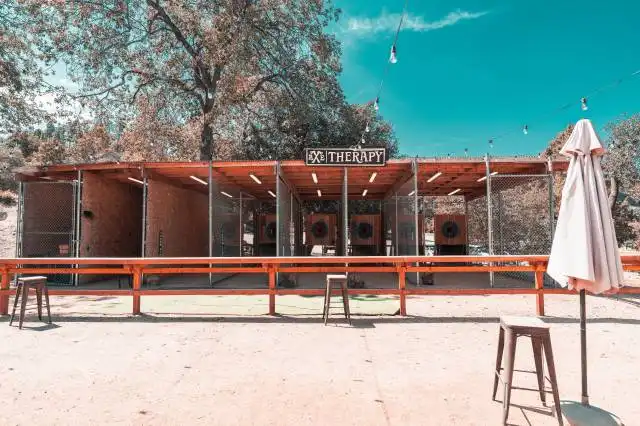Start an Escape Room Business
Unlocking Success Through Mystery: Your Escape Room Venture Awaits!
| Updated


ESCAPE ROOM BUSINESS
Ready to lock in profits with a twist of mystery? An Escape Room business is your key to success! This unique venture offers immersive, real-life gaming experiences where participants solve puzzles and riddles to 'escape' a themed room. As the mastermind behind the suspense, you'll design captivating storylines and brain-teasing challenges, making every room a labyrinth of fun and intrigue. Dive into this exciting entrepreneurial labyrinth and watch your entrepreneurial journey truly unfold in an interactive, enchanting fashion.
Jump to Business Plan
RELATED BUSINESS IDEAS
Browse ALL Hospitality & Leisure Ventures Business Ideas
Discover Your Perfect Domain
Unlock the door to your online success with our hand-picked selection of premium domain names. Whether you're starting a new venture or rebranding an existing one, the right domain can set the tone for your digital presence. Browse through our curated list, each with its unique potential to enhance your brand's visibility and credibility.
ESCAPE ROOM MINI BUSINESS PLAN
This a quick reality check to help you identify the strengths and weaknesses of your business concept before you dive in.
Expected Percent Margin:
- Gross Profit Margin: 60-70%
- Net Profit Margin: 25-35%
Earnings Expectations:
- Daily Earnings: $400 - $800
- Weekly Earnings: $2,800 - $5,600
- Monthly Earnings: $12,000 - $24,000
- Annual Earnings: $144,000 - $288,000
Actions to Hit Those Numbers:
Start-up Costs:
- Initial Investment: At least $50,000-$70,000 for room setup, props, puzzles, and initial marketing.
Marketing and Customer Acquisition:
- Social Media: Engage regularly on platforms popular with your target demographic. Post customer team photos, introductory videos, and encourage reviews.
- Online Advertising: Utilize Google AdWords, Facebook ads, and local event listings.
Sales and Customer Experience:
- Staffing: Employ enthusiasts who can monitor games, provide hints, and ensure customer satisfaction.
- Booking Management: Use an online booking system to manage reservations and ensure maximum room utilization.
Cost Control:
- Rent: Opt for a location where rent does not exceed 10-15% of your expected monthly sales, and offers ample space for your rooms and waiting area.
- Utilities, Maintenance, & Insurances: Budget around $1,000-$2,000 per month.
Business Operations:
- Hours of Operation: Open at least 5-6 days a week, with extended hours on weekends.
- Customer Volume: Aim for 10-15 bookings per day at an average ticket price of $25-$30.
These are generalized estimations and can vary depending on location, economic conditions, and individual business strategies. Always consult with a financial advisor for personalized advice.
NOT WHAT YOU HAD IN MIND? Here are more ideas


Browse ALL Hospitality & Leisure Ventures Business Ideas
Grab Your Business Website Name
Before you get caught up in the whirlwind of setting up your business, invest in a domain name. It's a small but significant step that lays the foundation for your brand and makes it easier for customers to find and trust you. Just like you wouldn't build a house without securing the land first, don't build a business without securing your domain name.
"Why? Can't that wait?" Here's why it shouldn't
Step 1: Determine if Escape Room Business is Right Endeavor
Breakdown of Startup Expenses
Starting an escape room business requires a substantial investment. The most important startup expenses to consider are the cost of the physical space, the cost of the equipment, and the cost of marketing. The cost of the physical space will depend on the size and location of the space. The cost of the equipment will depend on the type of puzzles and props that are used. Finally, the cost of marketing will depend on the type of advertising and promotional materials that are used.
Breakdown of Ongoing Expenses
In addition to the startup expenses, there are also ongoing expenses to consider. These include the cost of staffing, the cost of maintenance, and the cost of supplies. The cost of staffing will depend on the number of employees needed to run the business. The cost of maintenance will depend on the type of equipment used and how often it needs to be replaced. Finally, the cost of supplies will depend on the type of props and puzzles used.
Examples of Ways to Make Money
There are several ways to make money with an escape room business. The most common way is to charge customers an admission fee. Other ways to make money include offering discounts for groups, selling merchandise, and offering corporate team building packages. Additionally, some escape rooms offer food and drinks for an additional fee. By offering a variety of services, escape rooms can increase their revenue and profitability.
Step 2: Name the Business
When it comes to naming your escape room business, it is important to choose a name that is memorable, creative, and easy to pronounce. It should also be something that is unique and stands out from the competition. Additionally, it should be something that reflects the type of escape room experience you are offering. Some tips for choosing a name include:
Brainstorming: Take some time to brainstorm potential names for your escape room business. Think of words that relate to the type of experience you are offering and come up with a list of potential names.
Research: Once you have a list of potential names, do some research to make sure the name is not already taken. Check to see if the domain name is available and if there are any trademarks associated with the name.
Get Feedback: Ask friends and family for their opinion on the potential names. This can help you narrow down your list and decide on the best name for your escape room business.
Make it Unique: Make sure the name you choose is unique and stands out from the competition. Consider adding a tagline or slogan to make it even more unique.
Keep it Short: Choose a name that is easy to remember and pronounce. Keep it short and simple so that it is easy to remember and people can easily find it online.
Consider Your Brand: Think about how the name you choose will reflect your brand. It should be something that captures the essence of your escape room business and resonates with your target audience.
Step 3: Secure Financing
Securing financing for your escape room business is an important step in the process. There are a few different ways to finance your business, including personal savings, loans from friends or family, and traditional bank loans. Depending on the size of your business, you may also consider venture capital or angel investors.
Personal Savings
Using personal savings is a great way to finance your business. If you have the funds available, you can use them to cover startup costs and ongoing expenses. It is important to make sure you have enough saved to cover the entire cost of starting and running your business.
Friends and Family Loans
Another option for financing your business is to borrow money from friends or family. This can be a great way to get the funds you need without having to take out a traditional loan. It is important to make sure you have a written agreement in place that outlines the terms of the loan and repayment schedule.
Bank Loans
Taking out a loan from a bank is another way to finance your business. Bank loans typically have lower interest rates than other forms of financing, but they also require a good credit score and collateral. It is important to shop around and compare different loan options to find the best rate and terms for your business.
Venture Capital and Angel Investors
Finally, if you are looking for a larger amount of funding, you may consider venture capital or angel investors. These investors typically provide larger amounts of money in exchange for a stake in the company. It is important to research these options carefully and make sure you understand the terms of the agreement before accepting any money.
Step 4: Find a Location
When choosing a location for an escape room business, there are several factors to consider. First, the location should be easily accessible for customers. It should also have enough space to accommodate the number of people that will be playing at one time. Additionally, the location should have adequate parking and be close to other businesses that can help generate more customers. Finally, the location should be secure and have enough space to store the necessary equipment and supplies.
Leasing or Buying a Location
Once a suitable location has been identified, the next step is to decide whether to lease or buy the property. Leasing a property is often the more cost-effective option, as it requires less upfront capital and allows for more flexibility. On the other hand, buying a property can provide more stability and control over the property. It is important to consider the pros and cons of both options before making a decision.
Securing the Location
Once a decision has been made to lease or buy a property, the next step is to secure the location. This includes signing a lease or purchase agreement, obtaining any necessary permits or licenses, and ensuring the property meets all safety and security requirements. Additionally, it is important to make sure the property is properly insured to protect against any potential liabilities.
Outfitting the Location
The final step in finding a location is to outfitting the property with the necessary equipment and supplies. This includes furniture, decorations, props, and other items needed to create an immersive experience. It is important to choose items that are durable and easy to maintain. Additionally, it is important to ensure that the items are safe and secure to protect the customers and employees.
Step 5: Design the Escape Room
When designing the escape room, it is important to consider the audience and the theme of the room. The design should be creative and engaging, while also being safe and secure. It is also important to consider the size of the room and the number of participants that it can accommodate. Additionally, it is important to consider the props and puzzles that will be used in the room. It is important to make sure that the props and puzzles are age-appropriate and that they are challenging enough to engage the participants.
Finding Props and Puzzles
When it comes to finding props and puzzles for the escape room, there are a variety of sources to choose from. It is possible to purchase props and puzzles from online stores, or to create them yourself. Additionally, there are a variety of escape room companies that offer props and puzzles for sale. It is important to make sure that the props and puzzles are age-appropriate and that they are challenging enough to engage the participants.
Hiring Staff
When it comes to hiring staff for the escape room, it is important to find people who are knowledgeable and passionate about escape rooms. It is also important to find people who are reliable and trustworthy. Additionally, it is important to consider the staff’s experience and qualifications. It is important to make sure that the staff is adequately trained and that they are able to provide a safe and secure environment for the participants.
Setting Prices
When it comes to setting prices for the escape room, it is important to consider the costs of running the business, as well as the demand for the escape room. Additionally, it is important to consider the competition in the area and the prices that they are charging. It is important to make sure that the prices are competitive and that they are fair for the participants.
Step 6: Create a Website
Creating a website for your escape room business is a great way to attract customers and increase your visibility. You should include information about your business, such as the types of games you offer, the cost of each game, and any special offers or discounts you may have. Additionally, you should include a contact page so customers can easily reach out to you if they have any questions. You should also include a blog section where you can post updates about your business, such as new games or special events. Finally, you should include a booking system so customers can easily book their escape room experience online.
Tips for Promoting Your Website
Once you have created your website, you should promote it to increase visibility and attract customers. You should start by creating social media accounts for your business and then post regularly to keep customers informed. Additionally, you should create content such as blog posts, videos, and infographics to share on your social media accounts. You should also consider running targeted ads on social media to reach potential customers. Finally, you should create a newsletter to keep customers up to date on any new games or special offers.
Step 7: Market the Business
When it comes to marketing an escape room business, there are a few different strategies that can be used. Social media is a great way to get the word out about the business and reach potential customers. Creating a website and using SEO techniques can also be beneficial. Additionally, it can be helpful to create a referral program, where customers can get discounts or other incentives for referring others to the business.
Advertising
In addition to marketing strategies, it can be beneficial to invest in some advertising. This could include placing ads in local newspapers, radio, or television. Additionally, it can be helpful to create promotional materials such as flyers or brochures that can be distributed in the local area. It can also be helpful to create a loyalty program, where customers can get discounts or other incentives for returning to the business.
Networking
Networking is another important part of marketing an escape room business. It can be helpful to attend local events and meetups to get the word out about the business. Additionally, it can be beneficial to join local business organizations, such as chambers of commerce or business associations. This can be a great way to make connections and get the word out about the business.
Online Presence
Finally, it is important to create an online presence for the business. This could include creating a website and social media accounts. Additionally, it can be helpful to create content such as blog posts or videos that can be shared on these platforms. This can be a great way to reach potential customers and build an audience.
Step 8: Hire Employees
When it comes to hiring employees, it is important to find the right people who are passionate about escape rooms and have the skills to make the business successful. It is also important to make sure that the employees have the necessary certifications and licenses to work in the industry. Additionally, it is important to make sure that the employees have the necessary skills to help customers with their escape room experience.
When it comes to hiring employees, it is important to conduct thorough background checks to ensure that the employees are trustworthy and reliable. Additionally, it is important to make sure that the employees have a good understanding of the escape room industry and the rules and regulations associated with it. Additionally, it is important to make sure that the employees are able to work well with customers and provide them with a positive experience.
It is also important to make sure that the employees have the necessary skills to help customers with their escape room experience. This includes having the knowledge to explain the rules and regulations of the escape room, answer customer questions, and help customers with any technical issues they may have. Additionally, it is important to make sure that the employees have the necessary skills to help customers with any puzzles or clues they may need help with.
Finally, it is important to make sure that the employees have the necessary customer service skills to make sure that customers have a positive experience. This includes having the ability to be friendly and helpful, as well as having the ability to handle difficult customers in a professional manner. Additionally, it is important to make sure that the employees are able to handle any complaints or feedback from customers in a professional manner.
Step 9: Open the Business
Opening a business can be a daunting task, but with the right preparation and research, it can be a successful endeavor. Before opening the business, it is important to make sure that all legal requirements are met, such as registering the business with the local government and obtaining the necessary licenses. Additionally, it is important to make sure that the business is properly insured and that all necessary safety protocols are in place. It is also important to create a marketing plan and to make sure that the business is properly staffed. Finally, it is important to create a budget and to make sure that the business is properly funded.
Tips for Advertising the Business
Once the business is ready to open, it is important to create an advertising plan. This should include a combination of online and offline marketing tactics, such as creating a website, utilizing social media, and creating print ads. Additionally, it is important to create a customer loyalty program and to offer discounts and promotions. It is also important to create a referral program and to reach out to local businesses and organizations to create partnerships. Finally, it is important to create a customer service plan and to make sure that the business is responsive to customer feedback.
EXPLORE MORE CATEGORIES
Browse ALL Business Idea Categories
TAKE THE NEXT STEPS










